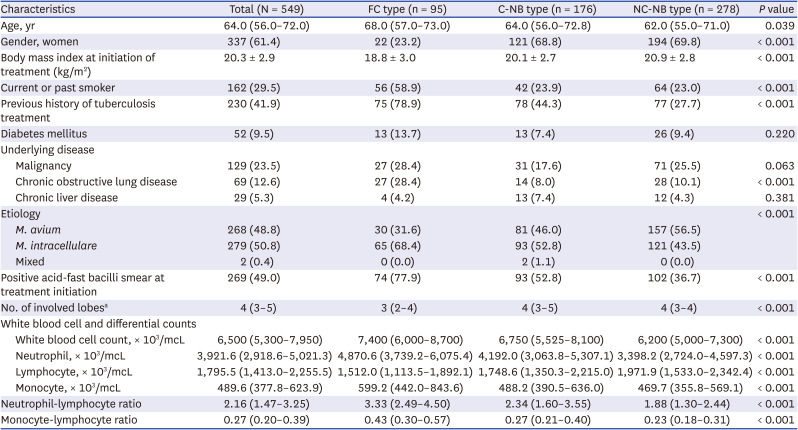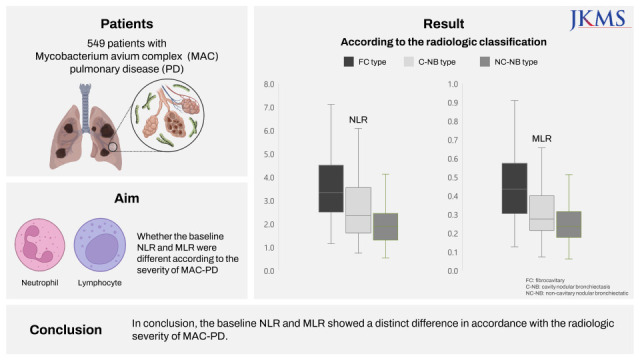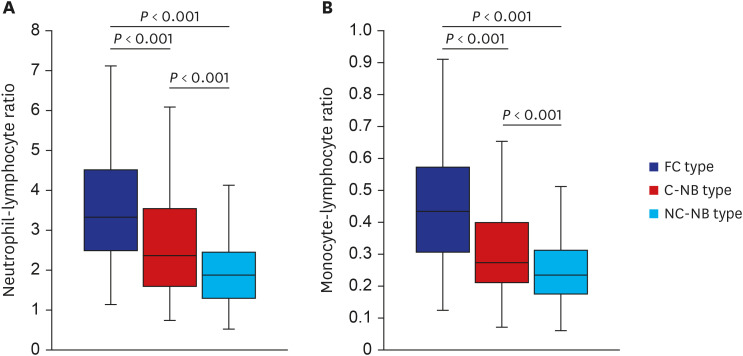1. Han Y, Kim SJ, Lee SH, Sim YS, Ryu YJ, Chang JH, et al. High blood neutrophil-lymphocyte ratio associated with poor outcomes in miliary tuberculosis. J Thorac Dis. 2018; 10(1):339–346. PMID:
29600065.

2. Yin Y, Kuai S, Liu J, Zhang Y, Shan Z, Gu L, et al. Pretreatment neutrophil-to-lymphocyte ratio in peripheral blood was associated with pulmonary tuberculosis retreatment. Arch Med Sci. 2017; 13(2):404–411. PMID:
28261295.

3. Iliaz S, Iliaz R, Ortakoylu G, Bahadir A, Bagci BA, Caglar E. Value of neutrophil/lymphocyte ratio in the differential diagnosis of sarcoidosis and tuberculosis. Ann Thorac Med. 2014; 9(4):232–235. PMID:
25276243.

4. Ngahane BH, Ebenezer AT, Eveline ND, Raïssa MN, Fernando KL, Lum CV, et al. Diagnostic value of leukocyte count abnormalities in newly diagnosed tuberculosis patients. Open J Respir Dis. 2019; 10(1):1–10.

5. Wang W, Wang LF, Liu YY, Yang F, Zhu L, Zhang XH. Value of the ratio of monocytes to lymphocytes for monitoring tuberculosis therapy. Can J Infect Dis Med Microbiol. 2019; 3270393. PMID:
31263513.

6. Daley CL, Iaccarino JM, Lange C, Cambau E, Wallace RJ Jr, Andrejak C, et al. Treatment of nontuberculous mycobacterial pulmonary disease: an official ATS/ERS/ESCMID/IDSA clinical practice guideline. Clin Infect Dis. 2020; 71(4):e1–36. PMID:
32628747.

7. Koh WJ, Moon SM, Kim SY, Woo MA, Kim S, Jhun BW, et al. Outcomes of
Mycobacterium avium complex lung disease based on clinical phenotype. Eur Respir J. 2017; 50(3):1602503. PMID:
28954780.
8. Jhun BW, Moon SM, Jeon K, Kwon OJ, Yoo H, Carriere KC, et al. Prognostic factors associated with long-term mortality in 1445 patients with nontuberculous mycobacterial pulmonary disease: a 15-year follow-up study. Eur Respir J. 2020; 55(1):1900798. PMID:
31619468.

9. Ong CW, Elkington PT, Friedland JS. Tuberculosis, pulmonary cavitation, and matrix metalloproteinases. Am J Respir Crit Care Med. 2014; 190(1):9–18. PMID:
24713029.

10. Yoon NB, Son C, Um SJ. Role of the neutrophil-lymphocyte count ratio in the differential diagnosis between pulmonary tuberculosis and bacterial community-acquired pneumonia. Ann Lab Med. 2013; 33(2):105–110. PMID:
23482854.

11. Lyadova IV. Neutrophils in tuberculosis: heterogeneity shapes the way? Mediators Inflamm. 2017; 2017:8619307. PMID:
28626346.

12. de Melo MG, Mesquita ED, Oliveira MM, da Silva-Monteiro C, Silveira AK, Malaquias TS, et al. Imbalance of NET and alpha-1-antitrypsin in tuberculosis patients is related with hyper inflammation and severe lung tissue damage. Front Immunol. 2019; 9:3147. PMID:
30687336.

13. Fenton MJ, Vermeulen MW. Immunopathology of tuberculosis: roles of macrophages and monocytes. Infect Immun. 1996; 64(3):683–690. PMID:
8641767.

14. Lavalett L, Ortega H, Barrera LF. Infection of monocytes from tuberculosis patients with two virulent clinical isolates of
Mycobacterium tuberculosis induces alterations in myeloid effector functions. Front Cell Infect Microbiol. 2020; 10:163. PMID:
32391286.
15. Rakotosamimanana N, Richard V, Raharimanga V, Gicquel B, Doherty TM, Zumla A, et al. Biomarkers for risk of developing active tuberculosis in contacts of TB patients: a prospective cohort study. Eur Respir J. 2015; 46(4):1095–1103. PMID:
26250497.

16. Urbanowski ME, Ordonez AA, Ruiz-Bedoya CA, Jain SK, Bishai WR. Cavitary tuberculosis: the gateway of disease transmission. Lancet Infect Dis. 2020; 20(6):e117–e128. PMID:
32482293.

17. Cohen R, Muzaffar S, Capellan J, Azar H, Chinikamwala M. The validity of classic symptoms and chest radiographic configuration in predicting pulmonary tuberculosis. Chest. 1996; 109(2):420–423. PMID:
8620716.

18. Kwon YS, Koh WJ. Diagnosis and treatment of nontuberculous mycobacterial lung disease. J Korean Med Sci. 2016; 31(5):649–659. PMID:
27134484.

19. Kwon BS, Lee JH, Koh Y, Kim WS, Song JW, Oh YM, et al. The natural history of non-cavitary nodular bronchiectatic
Mycobacterium avium complex lung disease. Respir Med. 2019; 150:45–50. PMID:
30961950.

20. Kim HJ, Kwak N, Hong H, Kang N, Im Y, Jhun BW, et al. BACES score for predicting mortality in nontuberculous mycobacterial pulmonary disease. Am J Respir Crit Care Med. 2021; 203(2):230–236. PMID:
32721164.

21. Kwas H, Guermazi E, Zendah I, Ben Jemia E, Khattab A, Khouaja I, et al. C-reactive protein and pulmonary tuberculosis: what correlation with disease severity. Eur Respir J. 2015; 46:PA2751.

22. Kirwan DE, Chong DL, Friedland JS. Platelet activation and the immune response to tuberculosis. Front Immunol. 2021; 12:631696. PMID:
34093524.






 PDF
PDF Citation
Citation Print
Print





 XML Download
XML Download